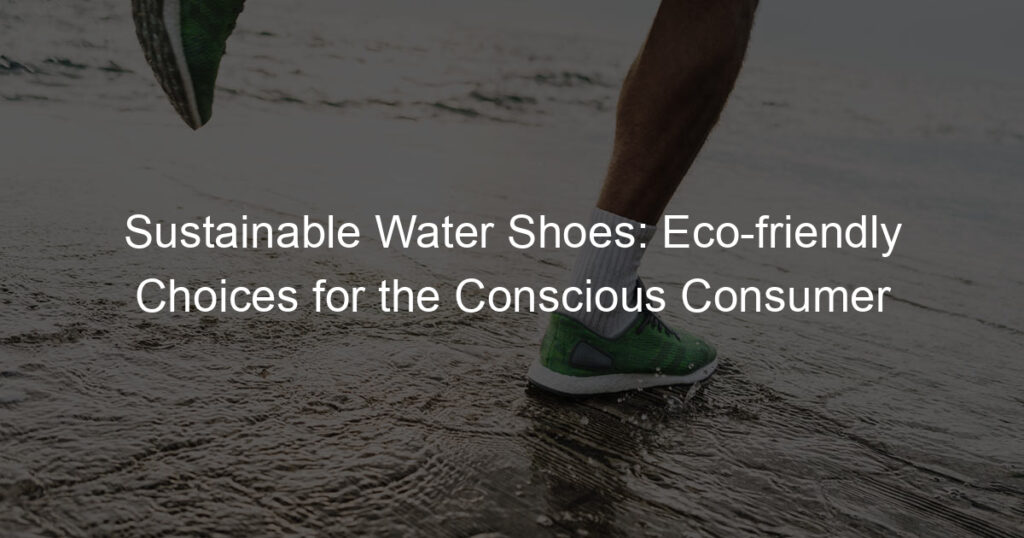In recent years, there has been a growing awareness of the need to make more sustainable choices in all aspects of our lives.
One area where we can make a significant difference is in the products we choose to wear on our feet.
Water shoes, in particular, have become increasingly popular for their versatility and protection, but many people are unaware that there are eco-friendly options available on the market.
Sustainable water shoes not only offer the same benefits as traditional water shoes but they are also made with environmentally friendly materials and production processes.
By choosing to wear sustainable water shoes, we can help protect our planet’s precious resources while still maintaining our active lifestyles.
Whether you enjoy water sports, hiking in wet conditions, or simply require additional traction and support in and around water, investing in sustainable water shoes is a responsible choice for both you and the environment.
Key Takeaways
- Sustainable water shoes are an eco-friendly alternative to traditional water footwear
- Environmentally conscious materials and production processes are used to create these shoes
- Opting for sustainable water shoes contributes to a healthier planet and a responsible lifestyle
The Concept of Sustainable Water Shoes
As I explore the world of sustainable shoes, I’ve noticed an increasing emphasis on eco-friendly water shoes. Sustainable water shoes are not only designed to protect my feet during water-based activities but also to minimize the environmental impact associated with their production and disposal.
One aspect that sets sustainable water shoes apart is the use of vegan materials. Traditional water shoes often utilize animal-based components such as glue derived from animal collagen.
However, sustainable water shoes favor plant-based or synthetic alternatives to prevent harm to animals and reduce the strain on our environment.
In addition to being vegan, these sustainable footwear options prioritize using recycled materials. For instance, some companies use recycled PET plastic from water bottles to create the fabric for the upper part of the shoe.
Repurposing these waste materials can give me peace of mind knowing that I’m contributing to a circular economy and reducing my footprint.
Lastly, sustainable water shoes often take into consideration the overall environmental impact of the product’s life cycle, from sourcing materials to manufacturing processes.
As a result, companies may strive to reduce water usage, energy consumption, and overall emissions in their production facilities.
Choosing sustainable water shoes can actively participate in protecting our environment and promoting a more sustainable future without compromising on style and function during my water adventures.
Fabrication Materials
When I think about sustainable water shoes, eco-friendly materials play a significant role in the choices I make.
There are several types of sustainable materials that can be used in the construction of water shoes:
- Organic Cotton: Cotton grown without using harmful pesticides or synthetic fertilizers. This material is soft, breathable, and biodegradable, making it an excellent choice for eco-friendly water shoes.
- Vegan Leather: A synthetic material made from a variety of plant-based and recycled materials. Vegan leather is an excellent cruelty-free alternative to traditional leather, and it can be used for water-resistant shoes.
- Wool: A natural, renewable fiber that’s often used for its comfort and insulation properties. Wool is a great sustainable material when sourced ethically, offering water-repellent and quick-drying properties.
- Bamboo: This fast-growing, renewable plant can be processed into fibers for fabric. Bamboo is naturally antibacterial and helps regulate temperature, making it an ideal material for water shoes.
- Recycled Materials: Used plastics, like PET bottles, can be broken down, melted, and extruded into fibers that can be woven or knitted into eco-friendly fabrics. By using recycled materials, water shoes can decrease their waste impact on the environment significantly.
- Cork: This sustainable material comes from the bark of cork oak trees, which regrows after harvesting. It’s lightweight, waterproof, and naturally antimicrobial, making it great for water shoes.
- Natural Rubber: Sourced from the Hevea tree, natural rubber provides excellent grip and flexibility in wet conditions, making it ideal for the soles of water shoes.
- TPU (Thermoplastic Polyurethane): A versatile material that can be made using bio-based, renewable resources, TPU is a more sustainable alternative to PVC. It’s flexible, waterproof, and can be used in shoe components, like protective toe caps or heel counters.
- Recycled Plastic Bottles: A highly useful source of recycled plastic, used plastic bottles can be transformed into fibers. The fibers can then be utilized for the creation of shoe fabrics, providing a practical approach to repurposing waste.
- Recycled Foam: Sourced from recycled automotive seating or foam mattresses, recycled foam can be incorporated into shoe insoles or midsoles. This environmentally friendly option minimizes waste while increasing comfort.
As you can see, there are many ways to weave sustainability into our water shoes. By using eco-friendly materials, we can make better choices for our feet, as well as the environment.
Comfort, Style, and Affordability
When I first started looking for sustainable water shoes, my main concern was finding a comfortable pair that wouldn’t hurt my feet during long walks on the beach or water-based activities.
Luckily, I discovered that many eco-friendly water shoes prioritize comfort as much as sustainability. They often feature cushioned insoles, breathable uppers, and adjustable closures, ensuring a perfect fit for any foot.
I also wanted my sustainable water shoes to have a touch of style and be fashionable enough to wear outside of the water. Thankfully, there are numerous eco-friendly brands that cater to various tastes, offering designs from sleek and minimalist to vibrant and playful.
Some even have the elegance and luxury of high-end sandals, making them suitable for both casual outings and special occasions.
Another important factor for me was affordability. I didn’t want to spend a fortune on water shoes, no matter how sustainable they were. To my delight, I found that eco-friendly options come in a variety of price ranges, making them affordable for any budget.
This makes it even easier for me to make environmentally conscious choices without breaking the bank.
As someone who values both style and sustainability, I’m thrilled to see this range of comfortable, fashionable, and affordable eco-friendly water shoes on the market.
It’s now easier than ever to make responsible choices while still looking and feeling great.
Popular Brands in the Market
Keep
I recently discovered Keep, a brand that offers vegan and eco-friendly shoes. They use sustainable materials, like natural rubber and organic cotton. Keep is an excellent option for those who care about the environment and want stylish water shoes.
Allbirds
My personal favorite, Allbirds, also offers sustainable water shoes. Their shoes are made from renewable materials like eucalyptus tree fibers and sugarcane. These materials are not only eco-friendly but also comfortable and stylish.
Native Shoes
Native Shoes is another popular brand offering sustainable water shoes made from EVA foam, a lightweight and comfortable material. What I love about Native Shoes is their commitment to creating a 100% life cycle for their products, ensuring their shoes are more eco-friendly.
Thousand Fell
Thousand Fell is a newcomer in the sustainable footwear industry, their water shoes are made from recycled materials and feature a unique end-of-life recycling program. I appreciate their commitment to keeping shoes out of landfills by offering recycling options.
Nisolo
Nisolo is a brand that produces ethically made, eco-friendly shoes. I was happy to find that they offer a range of sustainable water shoes made from high-quality leather. These shoes are durable and stylish, making them a great choice for eco-conscious consumers.
TOMS
TOMS has been making sustainable shoes for years, and their selection of eco-friendly water shoes doesn’t disappoint. I particularly like that for every pair of TOMS shoes sold, they give a pair to a person in need.
Veja
Veja is an innovative brand that focuses on ethical and eco-friendly practices. I found that their water shoes are made using sustainable materials like organic cotton and recycled plastic bottles. It’s great to see a brand committed to both social and environmental responsibility.
Flamingos Life
Flamingos Life is a fantastic brand offering vegan and eco-friendly water shoes. They use materials like corn waste and recycled PET bottles in their shoes. I was impressed to learn that they even plant trees for every purchase made.
Vivobarefoot
Vivobarefoot offers minimalist water shoes that are perfect for those who prefer a barefoot-like feeling. Their shoes are made from eco-friendly materials like algae and recycled plastic. I love how they focus on both sustainability and functionality.
Reebok
Even some well-known brands have begun to focus on sustainability. Reebok, for example, has introduced eco-friendly water shoes made from materials like algae foam and recycled polyester. I appreciate that they’re making an effort to be more environmentally conscious.
Stella McCartney
Stella McCartney is a luxury brand well-known for its commitment to sustainability. They offer stylish and eco-friendly water shoes made from innovative materials like faux leather and recycled polyester. I like that they prioritize both style and sustainability.
Cariuma
Cariuma is a Brazilian brand offering sustainable and comfortable water shoes. They use raw materials like bamboo, organic cotton, and natural rubber. I was pleased to learn that they also work with environmental organizations to offset their carbon emissions.
Circular Economy and Waste Management
As I explore the world of sustainable water shoes, it’s important to consider how our choices can contribute to a circular economy and effective waste management. In the footwear industry, adopting a zero-waste policy and minimizing carbon emissions can substantially lower our environmental impact.
Water shoes, like any other footwear, leave a carbon footprint. By selecting eco-friendly options, I can reduce my personal contribution to carbon emissions. Many sustainable water shoe brands have recognized the need for a closed-loop process and have implemented recycling initiatives.
By making use of recycled materials, these brands are actively working to minimize waste in the production process.
In a circular economy, products are designed to last longer, be more easily repaired, and eventually be recycled into new products. Sustainable water shoe brands are embracing this concept by creating durable shoes with replaceable components, cutting down on unnecessary waste, and reducing their overall carbon footprints.
By choosing water shoes made from recycled or sustainably sourced materials, I am not only limiting waste but also supporting the transition to a circular economy.
Opting for brands that focus on ethical and eco-friendly production methods can make a significant difference in reducing carbon emissions and the overall environmental impact.
To summarize, by making informed and sustainable choices when it comes to water shoes, I can support a circular economy and contribute to effective waste management.
Ultimately, these choices can make a difference in preserving our planet for future generations.
Extra Features and Innovations
I’ve discovered some fantastic features and innovations in sustainable water shoes that I want to share with you. Some brands have really gone the extra mile to create eco-friendly choices in footwear, even going as far as using vegan materials and recycled elements.
One example is the rise of vegan sneakers, which are made without using any animal-based materials. Many of these sneakers also use eco-friendly alternatives to conventional materials like PU and EVA, making the manufacturing process cleaner and more sustainable.
Many brands now also use recycled plastic shoelaces as part of their design. It’s a great way to reduce waste and upcycle materials that would have otherwise ended up in landfills or the ocean.
In addition to shoelaces, we are seeing increased use of recycled water bottles to create fabric for the shoes. This not only helps keep plastic waste out of our waterways but also conserves natural resources.
Some noticeable innovations include the CleanCloud technology, which incorporates eco-friendly practices in the shoe-making process by reducing harmful emissions and utilizing more sustainable materials.
CleanCloud technology has been a significant breakthrough in the realm of sustainable footwear and is now being implemented by various companies to make their products more environmentally responsible.
Eco-friendly innovations in sustainable water shoes don’t stop here. Manufacturers are continually researching and experimenting with new materials and processes to make their shoes even more planet-friendly.
So, when choosing your next sustainable water shoes, keep an eye out for these extra features and innovations, knowing that by doing so, you’re making a positive impact on the environment while still enjoying stylish, comfortable, and functional footwear.
Environmental Impact and Responsibilities
As I started researching sustainable water shoes, I realized how important it is for us to consider the environmental impact and our responsibilities as consumers.
There are a few main factors that contribute to the eco-friendliness of these shoes, and I’d like to share with you some of the aspects that make them a responsible choice.
First, I discovered that many sustainable water shoes have a lower carbon footprint. This means that their production process emits fewer greenhouse gases, like carbon dioxide, into the atmosphere.
By choosing shoes made from sustainable materials and manufacturing processes, we can help to reduce our overall carbon emissions.
Additionally, some companies have implemented recycling programs, allowing customers to return their worn-out shoes for recycling. This not only reduces the amount of waste that ends up in landfills but also allows for the reuse of materials, further decreasing the shoes’ carbon footprint.
What I also found interesting is that many sustainable water shoe manufacturers prioritize the use of eco-friendly materials, such as natural or recycled rubber, ethically sourced textiles, and water-based adhesives.
This not only reduces the impact on the environment but also helps to support responsible sourcing practices.
One of the main concerns when it comes to water shoes is the potential for them to contribute to microplastic pollution in our oceans and waterways. I found out that some companies address this issue by using materials that break down naturally over time rather than persisting as harmful microplastics.
In summary, by choosing sustainable water shoes, we’re not only making a responsible decision for the environment but also supporting ethical manufacturing practices and reducing our carbon footprint.
The next time I shop for water shoes, I will definitely be keeping these factors in mind.
Ethical Business Practices
When I started researching sustainable water shoes, I made sure to focus on companies that prioritize ethical business practices. One important factor I considered was the provision of fair wages to those who create the products.
By ensuring workers receive fair compensation, we can feel good about supporting a brand and the people behind it.
A key indicator of a conscious company is the certified B Corporation status. Companies with the B Corp certification meet the highest standards of social and environmental performance.
This means they prioritize both the planet and the people involved in their supply chain.
Transparent production practices are another aspect I looked for in my search for eco-friendly water shoes. When a company is transparent about its production process, we can better understand what goes into making the shoe and how it affects the environment and communities.
This openness is essential for informed purchasing decisions and fostering trust between consumers and businesses.
Lastly, I wanted to mention the value of artisan-made products. Some sustainable brands work closely with experienced artisans who handcraft the products. This approach not only showcases the amazing craftsmanship but also helps preserve unique cultural traditions.
By supporting these companies, we are supporting these artisans and their communities.
So, when you’re in the market for eco-friendly water shoes, consider brands that prioritize ethical business practices. Your choices matter, and they can contribute to a greener and fairer world for all.
Frequently Asked Questions
What are some popular eco-friendly shoe brands?
I’ve come across several popular eco-friendly shoe brands that prioritize sustainability. Some of these include Allbirds, VEJA, Saola, and Rothy’s. These brands use sustainable and recycled materials to create stylish and comfortable shoes while minimizing their impact on the environment.
How are sustainable materials used in shoe production?
Sustainable materials can be incorporated into various stages of shoe production. For instance, brands may use recycled plastic bottles to create fibers for the shoe’s upper, while others use natural materials like bamboo or organic cotton.
Further, eco-friendly soles can be made from recycled rubber or cork. Some brands even employ water-based adhesives and soy-based inks to further reduce the environmental impact.
What types of eco-friendly men’s shoes are available?
There’s a wide variety of eco-friendly men’s shoes available to suit different tastes and needs. You can find casual and dress shoes, sneakers, and even boots made from sustainable materials.
Brands like Allbirds offer a variety of styles, such as slip-ons, lace-ups, and high-tops, all made using eco-conscious practices.
Which eco-friendly sneakers are trending?
Some trending eco-friendly sneakers include the VEJA V-12, Allbirds Tree Runners, and Saola Cannon sneakers. These sneakers are popular for their combination of style, comfort, and sustainable materials.
They cater to the growing demand for environmentally conscious footwear options without sacrificing on design.
What are the best eco-friendly running shoes?
When it comes to eco-friendly running shoes, some of the best options include the Allbirds Tree Dashers, the Adidas Ultraboost made with Parley Ocean Plastic, and the Brooks Ghost 14 made with recycled polyester.
These shoes are not only stylish but also provide excellent support and cushioning for a comfortable running experience.
Where can I find sustainable, minimalist shoes?
If you’re looking for sustainable, minimalist shoes, brands such as VivoBarefoot, Xero Shoes, and Lems Shoes offer a variety of options. These companies focus on using eco-friendly materials and creating footwear with minimal environmental impact.
You can find minimalist shoes for running, hiking, and everyday wear in their collections.









